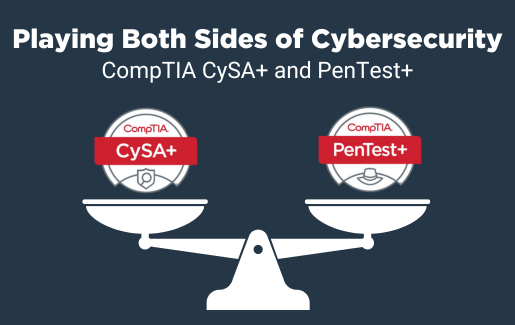 In cybersecurity, as in the military, sports and more, a solid defense is nothing without an equally strong offense. You can’t just sit back and wait – you need to take action. Cybersecurity professionals need to find system weaknesses before cybercriminals do, and that’s where security analyst and penetration testing skills come in.
In cybersecurity, as in the military, sports and more, a solid defense is nothing without an equally strong offense. You can’t just sit back and wait – you need to take action. Cybersecurity professionals need to find system weaknesses before cybercriminals do, and that’s where security analyst and penetration testing skills come in.
CompTIA Cybersecurity Analyst (CySA+) validates the defensive skills needed to protect a network, while CompTIA PenTest+ validates the offensive skills needed to attack it. Both certifications seek to discover and mitigate (fix) vulnerabilities before the enemy discovers and exploits them.
Both CompTIA Cybersecurity Analyst (CySA+) and CompTIA PenTest+ are intended for intermediate-level cybersecurity professionals. While CompTIA CySA+ focuses on defense through incident detection and response, CompTIA PenTest+ focuses on offense through penetration testing and vulnerability assessment.
CompTIA CySA+ involves proactively monitoring networks, detecting, responding to threats, attacks, and vulnerabilities and demonstrating competency of current trends. It’s intended for cyber professionals tasked with incident detection, prevention and response through continuous security monitoring.
CompTIA PenTest+ involves launching attacks on systems, discovering vulnerabilities and exploiting them. It’s intended for cybersecurity professionals tasked with penetration testing and vulnerability management.
Red Team and Blue Team Testing
A critical component in the cybersecurity landscape is red team/blue team testing, designed to simulate real-world cyberattacks and evaluate an organization's security posture. This approach involves two distinct groups: the red team, which emulates potential attackers, and the blue team, which defends against these simulated threats. Security analysts and penetration testers play vital roles in this process, working together to identify vulnerabilities and strengthen an organization's defenses.
In the context of red team/blue team testing, security analysts primarily function as members of the blue team. They are responsible for monitoring and analyzing an organization's security infrastructure, detecting potential threats and responding to incidents. By leveraging their expertise in threat intelligence, risk assessment and incident response, security analysts help organizations build robust security measures and maintain a proactive defense against cyberattacks.
On the other side, penetration testers (also known as ethical hackers) typically form the core of the red team. Their primary objective is to identify and exploit vulnerabilities in an organization's systems, networks and applications, simulating the tactics and techniques used by real-world adversaries. Through their rigorous testing and assessment, penetration testers provide valuable insights into potential weaknesses, allowing organizations to prioritize and remediate vulnerabilities before they can be exploited by malicious actors.
Red team/blue team testing is an essential practice in the field of cybersecurity, with security analysts and penetration testers playing crucial roles in safeguarding an organization's digital assets. By working together in a simulated adversarial environment, these professionals help organizations stay one step ahead of cyber threats and ensure the integrity, confidentiality and availability of their critical systems and data.
CompTIA CySA+ covers the following technical areas that focus on defense:
- Detect and analyze indicators of malicious activity
- Understand threat intelligence and threat management
- Respond to attacks and vulnerabilities
- Perform incident response
- Report and communicate related activity
CompTIA PenTest+ covers the following technical areas that focus on offense:
- Plan and scope a penetration testing engagement
- Understand legal and compliance requirements
- Perform vulnerability scanning and penetration testing using appropriate tools and techniques and then analyze the results
- Produce a written report containing proposed remediation techniques, effectively communicate results to the management team and provide practical recommendations
The CompTIA Difference: Hands-On Performance-Based Testing and Teamwork
CompTIA CySA+ and CompTIA PenTest+ are performance certifications, and the exams include hands-on performance-based questions as well as multiple choice questions, requiring test takers to perform security analyst, penetration testing and vulnerability assessment job tasks during the exam, depending on the exam taken.
The CompTIA Cybersecurity Career Pathway
CompTIA CySA+ and CompTIA PenTest+ are positioned at the intermediate-skills level of the CompTIA Cybersecurity Career Pathway. Depending on your course of study, CySA+ and PenTest+ can be taken in any order but typically follow the skills covered by CompTIA Security+. Although the two exams teach opposing skills, they are dependent on one another. The most qualified cybersecurity professionals have both offensive and defensive skills, which are sometimes called purple team skills.
CompTIA CySA+ validates the knowledge, skills and abilities related to many cybersecurity job roles, including the following:
- Security analyst
- Security Operations Center (SOC) analyst
- Incident response analyst
- Vulnerability management analyst
- Security engineer
- Threat hunter
CompTIA PenTest+ validates the knowledge, skills and abilities of cybersecurity roles that utilize penetration testing, including:
- Penetration tester
- Security consultant
- Cloud penetration tester
- Web app penetration tester
- Cloud security specialist
- Network security specialist
- Information security engineer
Validate your defensive and offensive cybersecurity skills with CompTIA CySA+ and CompTIA PenTest+. Download the exam objectives to get started.

